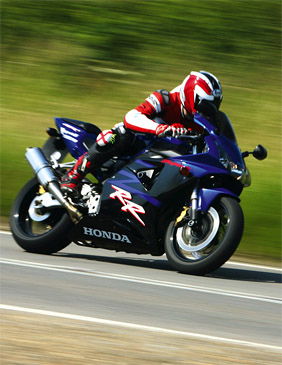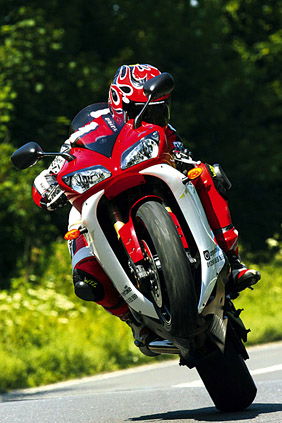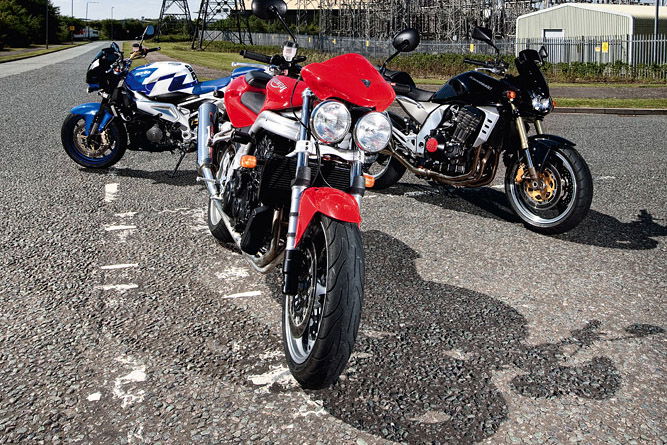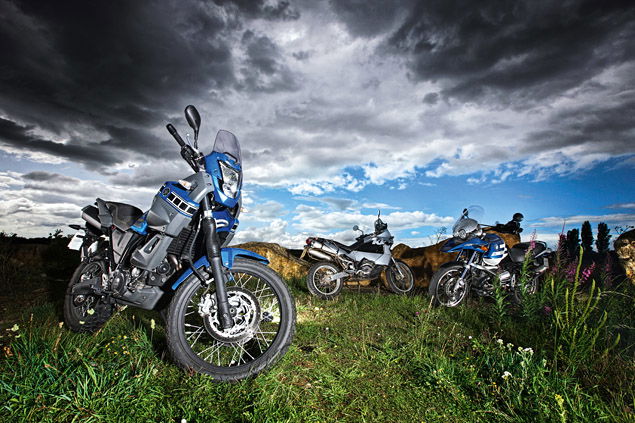Aprilia RSV Factory vs. Yamaha R1 vs. Honda CBR954RR
Three of the very finest 1000cc superbikes ever made; the Honda CBR954 Fireblade, Aprilia RSV1000R Factory and the Yamaha R1 are now at bargain prices.

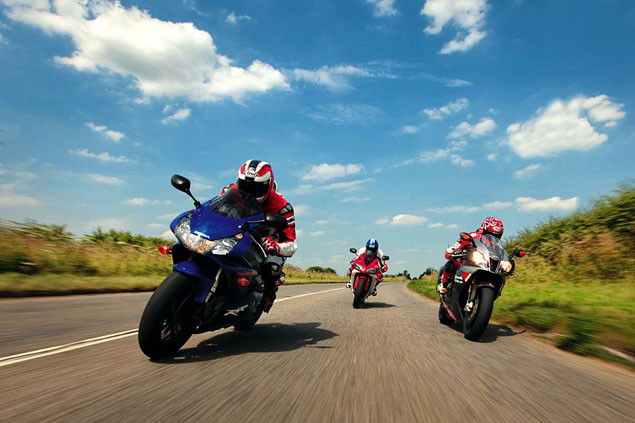
There was a time, not so long ago, that sportsbikes looked as good as they went. The original YZF is a prime example. Then mass centralisation, catalytic converters and aerodynamic efficiency got in the way. Suddenly, function overtook form - and they’ve been that way ever since. Ultra-fast, incredibly rapid, but definitely a bit on the Susan Boyle side of things.
Meanwhile, used bike prices have been tumbling, making serious performance more affordable than ever before.
Having scoured the dealer ads, we got our hands on a fairly high mileage 2003 R1 in decent, almost original condition at the giveaway price of just £3999.
Not only that, we got one of its direct rivals of the same vintage lined up – a Honda CBR954RR Fireblade at £4599 and an absolutely mint Aprilia RSV1000R Factory with low mileage and more bling chassis parts than you can shake a worn out kneeslider at for just £4999.
So, with our budget set between four and five grand, we headed off to the open spaces and sweeping bends of Buckinghamshire to find out if half the price actually means double the fun.
��
Aprilia RSV1000R
APRILIA RSV1000R Factory
Sexy Italian designer wear at Primark prices
Click to read: Aprilia RSV1000R Factory owners reviews
Something doesn’t add up. Maybe it’s just not a big seller, perhaps it’s plain unpopular, possibly it’s just that people are scared of buying second hand Italian bikes or it could just be that my calculator’s broken. These are the only reasons my befuddled mind can come up with for the tiny price tag on this massively attractive piece of low-mileage Italian exotica.
I mean, just look at it. Öhlins forks, shock and steering damper, radial Brembo brakes, lightweight OZ wheels, carbon fairing parts and a chassis and swinging arm that look as though they’ve been lifted straight out the back of a MotoGP race truck. All for less than five grand? Whatever the reason for the massive depreciation, that’s someone else’s problem – as a second hand buy, the RSV is an absolute steal.
Jumping on the Aprilia from either of the Japanese bikes, the initial feeling is of a bike that’s racetrack hard. The low clip-on bars feel spread wide apart too, giving plenty of leverage for a swift turn in, but putting a fair amount of weight on your wrists. There’s a real feeling of race focus to a bike that works brilliantly on the racetrack. Handy if you’re keen on track days. But if you’re not and prefer to get your kicks on the road, then the firm suspension and even firmer seat pad can soon become a bit of a pain in the arse in more ways than one.
With only 4221 miles showing on the clocks, the bike has a box fresh feel to it. The previous owner clearly never ventured out in the rain, preferring instead to ride just 844 dry miles per year at a cost of £1.25 for every mile covered. That’s not including fuel, tyres and insurance; that’s just the depreciation. If you happen to buy this bike, please feel free to exercise your right to feel impossibly smug.
Trundling along, worrying about wearing it out, really doesn’t do the Aprilia justice. Just like the suspension, the free-revving vee-twin engine is at its best when it’s worked hard. The gearing is very tall with low down fuelling that’s lumpier than school custard and lots of arm-pump inducing clutch slip is required to keep things smooth at slow speeds. And the engine runs hotter than a nuclear sub station. Not ideal on a warm day in town.
But on a warm day out of town, on the right roads, the Aprilia is fantastic. Keep the motor out of its sick spot, the crank spinning above 3,000rpm and all is well with the world, the twin upswept exhausts gargling a deep bossa nova with the spent gases through the slightly clunky gear changes from that growling sixty-degree vee-twin motor.
Ridden hard, on corner entry and mid corner is where the Aprilia feels at its sublime best, the DNA from years spent making the world’s sweetest handling 250GP bikes clearly running through the RSV’s chassis.
It is slightly slower steering and doesn’t change direction quite as quickly as the Japanese bikes but on fast, sweeping, ton plus corners, it’s hard to find a better front end. Leave the braking way late, let go of the lever early and just let it run through the corner, right on its ear but always beautifully composed, delivering virtually telepathic feedback to the rider.
The Aprilia is an exquisite piece of engineering that you need to take time to gel with and isn’t a bike that you can simply jump on and feel at home with from the off. It’s not the Japanese girl next door it’s the Italian supermodel – not particularly easy to live with but when it all comes together – spectacularly rewarding.
Verdict
Champagne for beer money
Rating: 4/5
For: Stonking vee-twin motor with a high quality chassis and cycle parts
Against: Too track focused for long stints on the road and awkward at low speeds
Review your Aprilia RSV1000R Factory
Aprilia RSV1000R Factory Essential Info
Prices
From £4,699 (2005, 5,500 miles) to £9,500 (2009, 0 miles)
The later Aprilia RSV is a little more track-focused than it’s roomier predecessor. This could explain the low mileages even at the lower end of the price scale. As a used bike the Factory holds its value reasonably well but main dealer servicing is absolutely vital for these bikes – the slightest neglect and they soon lose the sparkle that makes them so special in the first place.
Only slightly updated in 2006, new RSVs are still available at £9,500 though with the new for 2009 RSV4 in showrooms, haggling shouldn’t be too hard as dealers will be fairly keen to shift them. Well cared for second hand bikes (such as our test bike) are the real bargains though, and so long as the service book bears that all important main dealer stamp, you should be onto a winner. Bag a test-ride if you can.
Instant upgrades
- Suspension set-up: The RSV isn’t the most comfortable road bike. If you’re more into road riding than track action, a visit to MCT Suspension in Stowmarket (www.mctechnics.co.uk), K-Tech in Leicestershire (www.k-tech.uk.com) or 100% Suspension (07715 490888) will keep the haemorrhoids at bay and improve feel.
- Levers: ASV levers add to the RSV’s good looks and offer more adjustment to both brake and clutch span. They’re £169.98 (www.calsport.co.uk) and fold out of the way if the bike goes to ground.
- Screen: The standard screen on the Mille is pretty low. A double bubble costs £70.50 (www.rsvr.net) and makes a big difference for distance work as well helping you to see how fast you’re getting there.
- Carbon: There are plenty of carbon bits to choose from for the RSV. A massive range is available from Maxmoto (www.maxmoto.co.uk) with prices starting from £53 right up to £162.99
Parts costs
Fuel tank: £1547.01
Headlight: £199.85
Lower right fairing panel: £287.47
Common faults
The most common problems stem from the electrical system. Many problems involve the bike intermittently cutting out. A wellknown fault is the stator wiring on the generator overheating and shorting out, which prevents the electrical system being charged. Another cause for the same symptom is the wiring to the fuel pump. This routes under the tank and is prone to getting trapped and shorting out.
One piece of advice worth considering is to buy official Aprilia parts when replacing anything on the bike. Just keep in mind that skimping on parts and servicing on an Aprilia is tantamount to vandalism and you’ll not go far wrong.
Honda CBR954RR
HONDA CBR954RR
The last of the fire-breathing Fireblades
Click to read: Honda CBR954RR owners reviews
As first impressions go, the CBR isn’t making a very good one. Like an unshaven, trainer-wearing slob at a job interview, the CBR’s rusty fasteners and Happy Shopper extras are making me feel nothing but pure disdain for this unkempt, poorly presented contender. Before I’ve even got my hands on the keys, the Honda’s CV is in the bin.
But looks can be deceiving. Sure, the tacky aftermarket endcan may as well be a Burberry cap, the cheap and nasty jack-up plates a dirty pair of Lonsdale slip-ons and the ugly black screen a chunky faux gold belcher chain. But underneath the grime and the tat lies a still-brilliant motorcycle.
For complicated reasons that only a Japanese engineering degree student would understand, Honda decided not to give the bike the usual 999 cubic centimetres of displacement, choosing instead to take the outgoing 929cc motor and squeeze it out to 954cc.
Side by side with the Yamaha though, you’d struggle to feel the difference and the Honda’s strong motor pulls cleanly, if a little clumsily compared to the precise-fuelling Yamaha. Personally, I’d blame that Burberry cap. Unlike the Yamaha, where its looks and performance belie the mileage, the Honda feels slightly tired.
It’s definitely not an inherent Honda thing, but this particular bike definitely hasn’t been very well looked after. The motor has a cammy top-end rattle that sounds at best like it needs a valve clearance check, at worst a top-end rebuild. Judging by the state of the rest of the bike, new oil would be a start as there’s little doubt that the previous owner wasn’t even slightly in love with this bike. Shit, if he was, perhaps he wouldn’t have parked it in the sea…
The suspension still does a decent job of combining with the excellent Pilot Power 2CT tyres to stick the bike to the road right up to the point your knee and those low-slung footrests gouge the tarmac. Honda’s knack for making bikes with neutral steering and a one-size-fits all riding position isn’t lost on the CBR954RR either – as an out-ofthe-crate package, the Blade’s balance is impressive.
The 330mm brakes on this model were monster when this bike was launched in 2003 and they’re still impressive today. The years have taken some bite off, but nothing that a set of lines and a pad-swap wouldn’t fix. Try as we might, we couldn’t get the 954 slapping its head as it was renowned for; the years have calmed the suspension. For many, this might be a good thing.
The motor still performs very well. My initial surprise at the blistering acceleration soon fizzles out as I find the next add-on deemed necessary by the former owner: a tooth off the front sprocket and two off the rear to give the bike quicker acceleration has altered the gearing, though on the road all it really achieves is a useless first gear, poor fuel economy on the motorway and an over-reading speedo. Such are the needs of the meddlers.
All these chav extras are such a shame, because as much as 2003 was a good year for Yamaha, it was a brilliant one for Honda, with many Fireblade enthusiasts citing this model as the best ever.
While the Fireblade has long since evolved as a model, you could say the 954 is the last of the head-shaking, slaphappy grin-makers; a Fireblade in its purest form. In a world now dominated by rider aids, emissions laws and safety features, this one’s going to be a future classic for sure.
Verdict
Safe bet, but this model needs to be cheaper
Rating: 3/5
For: Sharp steering, exciting chassis with an engine well suited to road use
Against: Questionable build quality and a limited ground clearance
Review your Honda CBR954RR Fireblade
Honda CBR954 Fireblade Essential Info
Prices
From £3395 (2002, 16,800 miles) to £5000 (2004, 7,000 miles).
There are plenty of ‘02-’03 ‘Blades in this price bracket, ranging from high-mileage shonker to pampered weekend pet. As a bike reknowned for reliability (it is a Honda after all), higher numbers on the clocks aren’t too much of a problem, as long as it’s been serviced regularly.
An ‘02 ‘Blade can be picked up for as little three grand. While some of the cheaper machines will have seen a fair few winters, there should still be plenty about that have been looked after.
Don’t expect to pay any more than five grand for an absolute minter with full Honda service history. This makes our test bike look like a bit of a bum deal to be totally honest, and for this kind of money you should expect everything to be in perfect working order, in immaculate condition with lower mileage.
Instant upgrades
- Exhaust: Standard Blade silencers tend to be ugly, heavy and mute the music emanating from the combustion chambers a little too well. A lightweight race can from GPR at £249.99 (www.gpr-motorcycleexhausts. co.uk), will make it look and sound the way it should.
- Power Commander: A PCIII at just £298.33 (www.dynojet.co.uk) will beef up the midrange, get rid of the bottom end flatness and give a few extra top end ponies.
- Steering damper: A recall was issued to calm the Fireblade’s lively handling, but if anything, it simply looked like Honda’s resistance to fit a steering damper as standard had bitten them on the arse. Try an Arrow damper for both form and function. (www.bandcexpress.co.uk)
- Stainless Bolt Kit: A bolt kit would go a long way to resurrecting the manky aesthetics of our rusty test bike. From £25 upwards (www.tastynuts.com)
Replacement part costs
Fuel tank: £531.79
Headlight: £377.84
Fairing lower: £375.74
Common faults
Honda issued a couple of recalls on the RR2/3 models Blade, one for the head bearing and one for the front forks. The head bearings were changed after the original set up was found by a few people to give stability issues, and the forks had the potential to allow water to ingress into the fork bottoms – both were sorted by Honda free of charge.
Other than the factory recalls, there’s little cause for concern with this model FireBlade, indeed the handful of reported problems are isolated cases and 99% of owners can do nothing but heap praise on the Honda. It is a very reliable machine if looked after, even though as can be seen on the test bike, Honda’s build quality can be compromised.
Yamaha YZF-R1
YAMAHA YZF-R1
Style and quality that's stood the test of time
Click to read: Yamaha YZF-R1
I have a confession to make. I’m a spoiled bastard. I get to ride all the latest bikes with next to no miles on them, in the best condition they’re ever likely to be in. Indeed, I am a lucky man. So having ridden the 80-odd miles from chez Hoyles just outside Peterborough to On Yer Bike in Aylesbury aboard my longterm test GSX-R1000K9, it would have been all too easy to have been dismissive of a bike worth half as much, with almost ten times as many miles on the clock.
But despite my privileged position, to my mind, the ’02-’03 R1 is still one of the best-looking bikes to come out of Japan. The red and white paint scheme doesn’t do it for me in quite the same way as the silver one does, but there’s no denying that those sexy angular lines look as good today as they did back then. Yep, just standing in the car park eyeing up the R1, sparkling in the July sunshine, I’m struggling to think of a better way to spend four grand.
But rose tinted specs are one thing, reality another, so it’s perhaps unsurprising that my first eager yank on the six-year-old R1’s throttle doesn’t have quite the same mind-blowing affect as it did when I rode the bike for the first time back in ’02. See, told you I’m spoiled.
An hour into the ride though, I’m swiftly transported back to how I first felt about this particular vintage of R1 all those years ago. Despite fairly hefty mileage, the engine sounds sweet, and performs as well as it ever did when it was new. In fact, if anything, slightly loosened up, the 20 valve motor feels more potent while the gearbox feels slicker than ever.
The power delivery, while not quite as excitable as today’s must-have metal, is still strong and smooth; the power building with a delectable wail from the standard titanium end can as the motor reaches its peak of 150bhp at around 10,000rpm – a touch early by today’s standards, but then the flipside to this longer stroke motor and the subsequent lower rev limit is useful midrange, and that’s no bad thing
Where many struggled, Yamaha got their first attempt at sports bike injection absolutely cock-on with the R1, the clever CV style throttle bodies and injectors working in sweet harmony throughout the rev-range, no matter what’s asked of them. The end result is seamless, glitch free drive.
Having covered almost 20,000 miles, it would be fair to assume that the handling wouldn’t be as it once was, that the fork oil would have been reduced to ditch water and that the shock would have lost most of its damping. Incredibly, while feeling less refined than the latest tackle, the steering still feels sharp and there are few tell-tale signs of high mileage, other than the honesty of the odometer.
The brakes do give the bike’s age away, though. In 2002, few of us could believe that you’d ever need more stopping power but here and now, in a world of GP-derived radial calipers and master cylinders, the Sumitomo brakes do feel a touch weak. Fresh brake fluid, a caliper service and a new set of pads would improve things, but if there’s one department where a few years make a difference, it’s definitely braking. But then as Jon Urry so succinctly put it: “you just need to squeeze the brake lever a little bit harder.”
An hour was all it took for me to feel completely at one with the Yamaha. The brakes might not be fantastic and the engine might be 20bhp down, but at a whopping £6000 less than the current R1, I could quite happily live with this bike in my garage… and still feel rather spoiled.
Verdict
Ladyboy - Oriental beauty with big bollocks
Rating: 4/5
For: Flexible motor combined with a well balanced chassis suitable for road and track
Against: Thirst for engine oil and the weakest brakes on test
Yamaha YZF-R1 Essential Info
Prices
From £3195 (2002, 19,000 miles) to £4,950 (2004, 3,000 miles). One of the prettiest bikes to come from Japan over the last decade, the ‘02-’03 model R1 has become something of an icon. This often-overlooked bike can be snapped up at bargain prices. With used prices starting as low as £3000, take the time to scour the ads for a minter and you’ll struggle to be disappointed.
Go for the most standard machine you can find, as these are more likely to have been owned by a more mature owner and will almost invariably have been better looked after. Bikes covered in stickers and anodised trinkets are best avoided – the R1 was always popular with the hardcore track rider, so pay attention and don’t buy a nail. If you’ve even the slightest doubts, walk away – there are plenty of clean R1s for sale.
Instant upgrades
- Rearsets: Gilles have an excellent reputation when it comes to making tough, high quality rearsets. They’re £336.69 for the R1 (www.calsport.co.uk) and are available in black, gold or titanium anodised finishes.
- Crash protectors: Always handy in the event of that embarrassing low speed spill, R&G crash bungs can spare your paper thin engine casings and your blushes for just £71.44 (www.rg-racing.com).
- Engine tuning: This model responds very well to tuning work, with 185bhp plus known to be squeezed from the strong motor. That’s way more than a 2009 R1. Ray Stringer can make your R1 sing from £1200. (07782 334480)
- Exhaust: A full Akrapovic titanium road system is available for £831.91 (www.calsport.co.uk) this not only sounds great but will help the motor breathe better – ideal if you’ve just had it tuned.
Parts costs
Fuel tank: £541.50
Headlight: £289.66
Lower right fairing panel: 322.52
Common faults
The R1 has a well-earned reputation for decent build quality and reliability. Problems only really come through owner neglect. The R1 is a great at wheelies, but if the rider isn’t, then expect damaged head bearings and check for signs of leaking fork seals. The R1 can take abuse well, but don’t take it for granted.
First and second gears can cause problems. Racing starts and clutchless shifts between first and second can cause the dogs to wear prematurely, and is a big and expensive job to rectify the damage. The clutch isn’t the strongest either so be sure to check how much free play is left in the cable – factor in at least £100 for a new clutch if it’s worn.
Overall
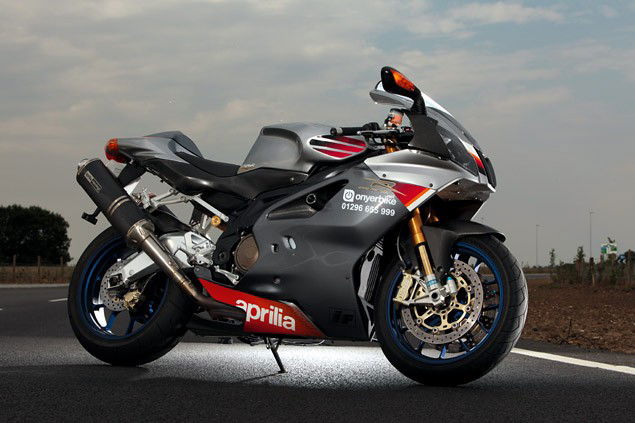
OVERALL
Finding a mint example of any of these three bikes isn’t particularly difficult, but it does require a little fortitude when wading through the classified ads.
If you bought the Honda we had on test at the screen price, I’d have to say that patience definitely isn’t one of your strong points.
To be fair, it still rides pretty well considering the apparent hard life it’s had which is testimony to Honda’s reputation for building bikes to last, regardless of who buys them. Arguably the last of the exciting, twitchy, pant-staining Fireblades, a 954 in good condition is a great second hand buy for the road.
It’s fairly handy on the track too, but limited ground clearance due to low footrests and a wide engine with a lack of top end never quite did it the justice it deserved.
The Yamaha we had for this test isn’t a bad bike, but with nearly 20,000 miles on its clock, you can expect it to burn a little oil and look a little tatty. But, it is very cheap and still dishes out plenty of thrills with superb handling, reasonable comfort over a distance and those stunning good looks all counting in its favour. As an every day bike, it represents cracking value for money.
But then we have the Aprilia. Some might warn you of the perils of buying an Italian bike; some might even tell you that you’re mad. But how can a well-serviced, 4000 dry miles only Aprilia RSV R Factory with all the bells, whistles and designer labels your heart could ever desire be anything other than a bargain when it’s offered at less than five grand?
It’s not as fast, nor is it as comfortable as the other two. It’ll cost you more to service and take more effort to keep looking pristine than the Japanese competition, too.
But the bottom line is what you get for your money. Why should you go for the Mondeo over the Impreza or take the Vectra instead of the Evo VIII? You’d be nuts to do that.
If you want something that will make you smile, the answer’s very easy. In fact, it’s as easy as R-S-V.
Specifications
Aprilia RSV1000R Factory
Price: £4999 (£10,725 new)
Top speed: 166mph Engine: 997cc, 8 valves, liquid-cooled, V-twin
Bore x stroke: 97 x 67.5mm Compression ratio: 11.8:1
Power: 143bhp @ 9,500rpm Torque: 76lb/ft @ 7,500rpm
Front suspension: 43mm Öhlins inverted forks, preload, compression, rebound adjustment
Rear suspension: Öhlins monoshock, preload, compression, rebound adjustment
Front brakes: Four-piston calipers, 320mm discs
Rear brake: Single-piston caliper, 220mm disc
Dry weight: 185kg (407lbs) Seat height: 810mm Fuel capacity: 18 litres
Colour options: Black, black/red, silver
Honda CBR954RR
Price: £4599 (£7,999 new)
Top speed: 170mph Engine: 954cc, 16 valves, liquid-cooled, in-line four
Bore x stroke: 75 x 56.5mm Compression ratio: 11.8:1
Power: 149bhp @ 11,250rpm Torque: 78lb/ft @ 9,500rpm
Front suspension: 43mm inverted forks, preload, compression, rebound adjustment
Rear suspension: Monoshock, preload, compression, rebound
Front brakes: Four-piston calipers, 330mm discs
Rear brake: Single-piston caliper, 220mm disc
Dry weight: 168kg (369lbs) Seat height: 815mm Fuel capacity: 18 litres
Colour options: Yellow/black, red/black, blue/black
Yamaha YZF-R1
Price: £3999 (£8,399 new)
Top speed: 175mph Engine: 998cc, 20 valves, liquid-cooled, in-line four
Bore x stroke: 74 x 58mm Compression ratio: 11.8:1
Power: 150bhp @ 10,000rpm Torque: 80lb/ft @ 8,500rpm
Front suspension: Inverted forks, preload, compression, rebound adjustment
Rear suspension: Monoshock, preload, compression, rebound adjustment
Front brakes: Four-piston calipers, 298mm discs
Rear brake: Single-piston caliper, 245mm disc
Dry weight: 176kg (387lbs) Seat height: 815mm Fuel capacity: 18 litres
Colour options: Silver/black, red/black, blue

